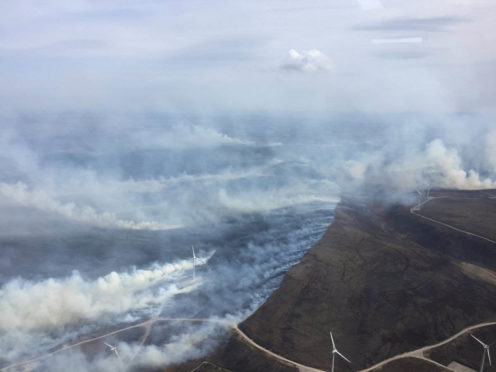
Scotland has already been hit by more wildfires this year than it experienced the whole of last year, experts revealed yesterday.
But senior firefighters and scientists warn the number will only rise due to climate change.
They also fear a dry winter has left countryside more combustible because leaves and other natural debris have not decayed as they would in wet weather.
There have been 114 wildfires in the UK already this year, compared with 79 for the whole of 2018, which was a record-breaking year.
More than 80 square miles of land has already been burnt this year – an area bigger than the size of Glasgow.
In Scotland, fire crews spent four days last week tackling a blaze in Moray, the UK’s biggest ever wildfire. Another fire in Skye spread across five square miles of forestry.
Alex McKinley, one of two Scottish Fire and Rescue Service wildfire tactical advisers, said: “The amount of wildfires we have already had this year passes the amount we had for the whole of 2018.”
The Moray blaze, at Paul’s Hill near Aberlour, destroyed about 23 square miles of land.
At its peak, it travelled at 15 miles per hour.
It was controlled by using fire to fight fire – the first time the tactic had been adopted in Scotland.
Mr McKinley described the wildfire in Moray as “apocalyptic”.
He said: “I was awestruck by the smoke plume that blocked out the sun and went right across the horizon.”
He was given a better view of the fire from above, in a Police Scotland helicopter.
He said: “I knew it was a large fire but what I was met with was an apocalyptic scene.
“We had 80 firefighters and 19 appliances there but they looked insignificant to the size and scale I was looking down on.
“For the first time ever in Scotland, we tackled the fire by using controlled burn lines.
“Human intervention alone wouldn’t have been able to tame this fire.
“We predicted where the fire was going, identified the most appropriate and safe place, lit a fire and that fire proceeded towards the advancing fire. When the two met, there was no fuel left and the fire was extinguished.”
Three helicopters water-bombing forestry areas also helped extinguish the fire.
Mr McKinley, a firefighter for 25 years and Highland area station manager, blamed the wildfires on longer dry spells, the result of climate change.
He warned: “We have always had wildfires in Scotland, but the number and intensity of them are definitely increasing.”
He added: “We are going to see bigger and more intense fires.”
Dr David Moore, of the UK National Centre for Earth Observation, said warm spells have increased from 5.3 days to 13.2 days in recent years.
This year’s Easter Monday and February were also the warmest on record in the UK.
Dr Moore said: “These came on top of the fact the UK has had a fairly dry winter with below-average rainfall.
“During a wet winter, most of the leaf litter from the previous year’s plant growth readily decays.
“When you get a drier or warmer spell, the leaves are able dry out more quickly and take longer to decay. This build-up of leaf litter makes more fuel available to burn.
“This is only one part of what starts the fires, of course. You still need something to ignite the leaf litter.
“Natural causes include lightning but this is unlikely, given the fires started during fine weather. So this points to a human source – arson, electrical faults, discarded cigarette ends, barbecues.”
He added: “Most wildfires in Europe are linked to human causes rather than natural causes, so the public have a part to play in prevention of these wildfires.
“The simplest prevention is to follow the Countryside Code.”

Enjoy the convenience of having The Sunday Post delivered as a digital ePaper straight to your smartphone, tablet or computer.
Subscribe for only £5.49 a month and enjoy all the benefits of the printed paper as a digital replica.
Subscribe